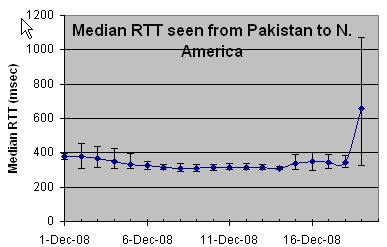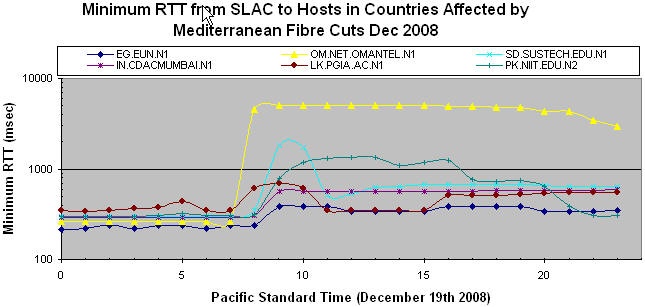...
Unreachability is defined in PingER terms as when none of the 10 pings sent each 30 mins gets a response. Looking at the PingER data despite the magnitude of these cuts and the large impact on losses there is no indication of unrteachability (100%) losses to any of the hosts measured in the affected regions. This does not mean that applications that require higher bandwidth than pings (1000bits/sec for a short period (~10secs) ), low loss or jitter or Round Trip Time (RTT) will not be badly impacgfed causing them to fail or to be effectively useless. On the other hand it does show that Internet connectivity was successfully maintained due to the use of redundant paths etc.
Round Trip Time (RTT)
An example Examples of the increase in RTT can be seen below in the plot of RTT seen from SLAC to a node host in Egypt. The sudden change in RTT from ~ 244ms to almost 400ms can be seen , a host at the Lahore School of Economic, Pakistan and a host at the NCP provider in Pakistan. All show an increase in RTT around 9-10am on Friday Dec 19th 2009 (UDT). . In the case of Egypt no loss of connectivity was observed at the time of the cut. In the case of Lahore there was a short period of no connectivity and over the days of the outage the RTT varied dramatically. In fact by Saturday for Lahore the losses dropped back to a more normal. NCP had a small increase in RTT and a long period of no connectivity later on Friday stretching into Saturday. These graphs illustrate the variability of bthe impact.
Another view of the effect of the RTT increases is seen in the plot below of the median RTTs measured (thed error bars are the 25% and 75%-tiles) from 3 monitoring hosts in Pakistan (NUST, COMSATS and NCP) to FNAL and SLAC (i.e. 6 pairs of monitor/remote hosts) for the first 19 days of December 2008.
Minimum RTT
The minimum (of 10 pings) seen from SLAC to selected hosts in various affected countries is seen below. The Top Level Domain of each host appears at the start of the host name (EG = Egypt, IN = India, LK = Sri Lanka, OM = Oman, PK = Pakistan, SD = Sudan). Not all hosts in each country was similarly affected, due to the use of different carriers. The sudden changes in miniumum RTT are presumably due the choice of different routes to carry the traffic. It is seen that steps in minimum RTT occur after the initial cut as carriers changed the routing. Be aware that just because the minimum ERTT may return to its previous fibre cut values does not mean the performance has been restored, the route though being short may have insufficinent capacity and still be heavily congested.
...





